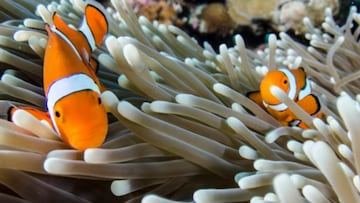Goodbye Nemo: The reason why the clownfish population is quickly decreasing
Clownfish numbers are declining at a worrying rate: here’s why.


The coral reefs of the Red Sea, once home to some of the world’s most vibrant clownfish populations, are turning silent. A powerful marine heatwave recently struck the region, wiping out vast stretches of sea anemones and, with them, their famous residents.
New research has shown that three Saudi Arabian Red Sea reefs were bleached by this heatwave, causing more than 66 percent of the anemones (Radianthus magnifica) and over 94 percent of clownfish (Amphiprion bicinctus) to die.
However, on further inspection, what looked like a sudden and tragic disappearance was, in reality, the result of years of rising ocean temperatures finally reaching a breaking point.
“There’s a maximum that these species just simply can’t handle”
“Maybe we’ve stumbled onto some kind of tipping point where there’s a maximum [temperature] that these species just simply can’t handle,” Morgan Bennett-Smith, a doctoral candidate at Boston University and lead author of the study, said.
Clownfish and sea anemones share one of nature’s most iconic partnerships. The anemones offer protection through their stinging tentacles, while clownfish bring nutrients and help keep their hosts clean: it’s a delicate balance that only works when the water remains within a certain temperature range.
However, when the Red Sea’s surface waters surged beyond that limit, the anemones expelled the algae that give them colour and energy. Deprived of nourishment, they turned pale and weak, a terrifyingly sad process known as bleaching.
“Everyone was really worried about what happens to coral reefs,” admits Bennett-Smith. “No one was really talking about the anemones.”
For clownfish, the loss of anemones was catastrophic. These fish are fiercely territorial and rarely leave their chosen hosts. Once their anemones bleached or died, the clownfish had nowhere to hide. Many perished within days, victims of stress and predators. Researchers surveying the reefs found that more than half of the anemones were gone, and the majority of the clownfish had vanished too.
Related stories
“The Red Sea had been considered a thermal ‘safe haven’ for these species, but this event shows otherwise,” Jules Kajtar, senior research scientist and physical oceanographer at the National Oceanography Centre, told National Geographic.
Get your game on! Whether you’re into NFL touchdowns, NBA buzzer-beaters, world-class soccer goals, or MLB home runs, our app has it all. Dive into live coverage, expert insights, breaking news, exclusive videos, and more – plus, stay updated on the latest in current affairs and entertainment. Download now for all-access coverage, right at your fingertips – anytime, anywhere.


Complete your personal details to comment